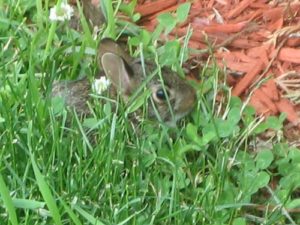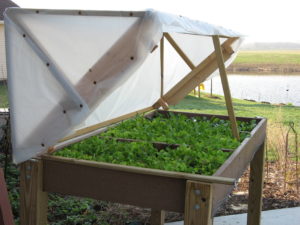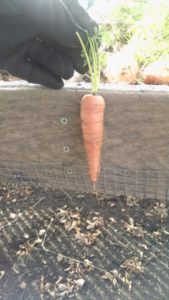It only takes a pot, some planting mix and seeds to grow your own salad greens at home.
I grew up thinking all salads were made of iceberg lettuce.
This was way “back in the 1900’s” to quote a teenage friend of mine– before there were multiple pages and racks of seed for salad greens available in catalogs and stores or the multitude of ready-to-eat salad greens we have today at the grocery store.
I do have a vague memory of a bright lime-green leaf lettuce growing in our home garden as a child. I remember my mom scolding me for eating pieces right out of the garden without washing it, but I don’t remember eating it at mealtimes with my family.
The world has come a long way from the iceberg lettuce and occasional leaf lettuce of my youth. In fact, a lot of salad mixes don’t contain much lettuce! If you take a closer look at the label of ‘spring mix,’ ‘baby greens,’ or ‘mesclun,’ usually much of it is not lettuce. These mixes usually contain an assortment of leaf lettuces, plus other greens like beets, endive, fennel, or mustard greens.
There are many different options for salad greens ready-to-eat from the grocery store, but one thing they have in common is the price. Specialty salad mixes usually cost significantly more than those containing mostly iceberg or romaine lettuce. For the cost of one ready-to-eat package of spring mix, you can buy enough seed to grow your own specialty salad mix for an entire season or more.
Growing spring salad greens in just about any size pot is simple—and could be considered a gateway drug to get you hooked on growing your own food.
I’ve had people stare at me in disbelief when they realize how easy it is.
Currently, the ground is too cold and wet for planting here, but its fine to plant a pot now. Plus a pot can be moved out of reach of local rabbits and can be moved indoors if the temperatures take a dive. Salad greens in general can tolerate light frosts, so you only need to worry if we have extended periods of freezing temperatures. As the weather warms, lettuce and some other salad greens will tend to flower and become bitter—but if you move your container into the shade, you can delay this growth and flavor change.
Recently, my friend Kiley from Making Health a Priority and I teamed up to make this video about planting salad mix in pots. It’s really a great way to put a “toe in” the world of vegetable gardening if you are a new gardener, but also a way to keep gardening if you’ve had to downsize or life is just throwing you curveballs and you don’t have time for a traditional vegetable garden.
Of course, if you’d like to and you have the space you can plant salad greens in the ground as part of a vegetable garden or inter-plant them with ornamental plants in other garden beds. But at my house, the local rabbits are particularly clever and can slide past all my fencing attempts with ninja-like ease. Every time I planted salad greens in the ground the rabbits in my yard just got fatter eating them.

They sure are cute!
My ears perked up when I heard about salad tables at a conference in 2007 where Jon Traunfeld from University of Maryland Extension presented the idea. A salad table is basically a raised bed held a few feet off the ground with four legs– out of reach of rabbits!
University of Maryland Extension has free plans and for those visual learners out there, the website also includes videos on planting and harvesting salad tables. Not long after that conference, it seemed like the salad table was everywhere– even on Martha Stewart!
In the years since I attended that conference, I noticed that several of my favorite gardening catalogs and stores have added table height gardens very similar in size to the salad table. They are very attractive, but honestly, the prices are pretty high, $200 and up. My husband built our salad table out of composite recycled plastic lumber for the table top, and treated lumber for the legs. The total cost was about $90. Using plain untreated wood for the table top would reduce the cost even more.
Remember that treated wood should not be in contact with soil used for growing vegetables. The risk of the wood treatment chemicals leaching into the soil and being taken up by vegetable plants in amounts great enough to do harm is debatable, but I prefer to err on the side of caution. Better to just avoid using these woods for constructing anything that comes in contact with soil for growing food.
My husband built our salad table in 2007, complete with his addition of a clear plastic “tent” to extend the season, which allowed us to harvest salad greens into the early winter months. The plastic tent has taken a beating—I think we’re on the third or fourth version now. But the table itself looks just as good now as it did ten years ago.

With the added tent on top, we have planted our salad table as early as February 5th and have harvested salad greens as late as Thanksgiving!
We have grown several different mixes of salad greens and made our own by combining seed of various individual greens. Greens aren’t the only crop the table can support– my husband and son planted carrots as an experiment last year, and they were delicious! I’ve also seen herbs and green beans grown in a standard salad table.

Carrots grown in the salad table won’t get longer than the depth of the table.
I use a soilless potting mix in my salad table, the same mix I use for containers of flowers; I would suggest the same if using a pot for salad greens. Garden soil is just too heavy and doesn’t drain well in a container.
At planting time, mix in some time-release fertilizer with the potting mix. You could also use compost if you prefer. Either way, you won’t need to fertilize later. I don’t always completely replace the mix from year to year, but I do add fresh mix to top off the table.
When planting your seed, the potting mix should be moist but not soaking wet. I don’t plant the seed in rows; rather I sprinkle the seed across the planting mix. I barely cover the seeds with additional mix and gently press down to ensure the seed has good contact with the soil, to speed up germination.
One reason I love growing my own salad mix is rooted in my frustration with wasting store-bought salad mix. It’s a rare event that we consume the entire package before it goes bad at my house. By growing my own, I only harvest what we need for the current meal.
I harvest as much as I need with scissors, then let the plants continue to grow. You do have to be careful to not scalp the plants clear to the ground, which would kill them. This “cut and come again” method should work for at least two or three rounds per planting.
As an added benefit, my son is fascinated with growing lettuce and is way more likely to eat what we grow than anything I’ve bought at the store. I’ve caught him many times eating lettuce right from the salad table—and yes, I do tell him he should wash it first, just like my mom said to me. But he still eats it anyway, just like I did. I guess the apple hasn’t fallen far from the tree.
If you liked this post, please subscribe to Grounded and Growing today and receive your copy of “15 Tips to Become a '15 Minute Gardener'” so you can spend less time working ON your garden and more time enjoying being IN your garden.! It’s absolutely free. When you join the Grounded and Growing community, you’ll finally take the garden off your “To-Do” list and allow yourself time to enjoy your garden and savor the peace and serenity there. I tell subscribers about new posts as soon as I hit ‘publish’ and send weekly-ish updates on what’s going on in my garden– good, bad AND ugly.
Just think of all that healthy dirt your son is taking in! I’ll bet he won’t have any problems with allergies.
Little boys grow best with a healthy dose of dirt and sunshine!